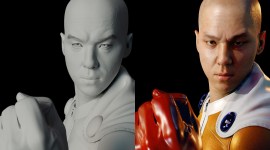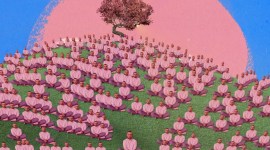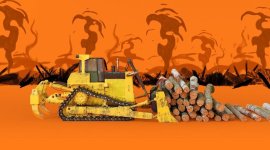
Going Viral on TikTok with CG
Already Been Chewed explains their animated Supra Boats spot that went viral in the first week.
Dallas-based creative studio Already Been Chewed (ABC) has been posting their work for iconic brands on social media for years and one of the many things they’ve learned is that CG doesn’t do so well on TikTok.
That’s okay with ABC Founder and Creative Director Barton Damer because their goal has never been to create content that goes viral. But it’s pretty amazing when it does, and that’s exactly what happened last summer when ABC posted the hero video they created for Supra Boats’ 2023 release.
Made using a combination of Cinema 4D, Houdini, and Redshift, the video got over a million views on TikTok in just the first week and killed it on Instagram and Twitter too.
We talked with Damer, as well as ABC’s Lead Motion Designer Bryan Talkish and Lead VFX Artist Mark Fancher about their Supra Boats video, as well as the four beauty-shot videos they created to support it.
Why do you think this got so much traction on TikTok?
Damer: We’re not really sure, especially since we usually play the game properly and post vertical versions of things, but I thought that was too claustrophobic in this case, so we posted the widescreen, and it blew up! Nobody posts anything widescreen on TikTok. It was exciting and Supra was thrilled, but we know we can’t expect that to happen, even though it would be great.


Are you focused mainly on social media these days?
Damer: Yeah, our business model for the last five years has been mainly about social media rather than broadcast. We’re basically creating movies that are 30 seconds long and they live on social media, primarily, though some make it into broadcast. That’s just the way things are now, more people see things on social media so that’s where clients want to spend their money.
Tell us how you came up with the interesting concept behind the hero film?
Damer: One of the challenges in our industry is figuring out how to do something that’s never been done before or taking something to a level that hasn’t been seen. The idea to form a product from nothing is not new, but we wanted to do that in a totally different way.
So we thought about wakeboards and how their hulls interact with the water. If you’re wakeboarding and going like 35 miles per hour, the wake is long enough to launch you high up into the air. I’ve always been intrigued by the idea of the hull manipulating the water to form wakes or waves, so I wanted to start out with some manipulation of water forming a wave and the boat itself.

That’s how we came up with the idea to use liquid to form the gel coat, which mixes with the lake water in the video and comes together to make the boat. Once the boat’s moving along at more like a surf speed, everything is meant to feel like the parts are slamming together through the forces of water and wind.
Talk about your process for animating the water.
Damer: As many people know, animating water is a huge undertaking in the 3D industry. We did some really intense animations inside C4D and combined then with Houdini liquid simulations.
Fancher: This spot has water FX interacting with nearly all aspects of the animation in over ninety percent of the frames. A lot of the shots were also very long, so it was a huge undertaking managing the collision data and sim times needed to keep the liquids flowing and stable throughout the shots.
The whole spot takes place on a massive boat wake sim with whitewater. We built a generic version of the wake based on the hull geometry and wake technology featured in the boat, and we used it as much as we could.
But there were certain instances where we needed to rerun it for custom scenarios, like the hull formation at the beginning, when boat parts come flying out of the water and for camera framings that were too tight or too wide, so we had to adjust the simulation resolution and domain size accordingly.


Then there were the water splashes. To achieve those, we brought almost all major parts of the boat, static and animated, into Houdini as alembic files. The animated parts were covered in water and used to influence the water splash velocities as the boat parts were flying into place.
The static parts were positioned to receive the splashes and provided the collision information necessary to keep things looking realistic. Then, everything was re-exported as alembic files and brought back into Cinema 4D for final look dev and rendering.
What can you tell us about the leather interior?
Talkish: The leather interior was created using a series of deformers and vertex maps for the wrapping of the seats. After completing the initial animation and blocking of the seats resting into position, vertex maps were painted around the seams and folds of the cushions.


The maps helped guide the influence of deformers placed around folds to articulate the cushions’ flaps. It’s very similar to weight painting on characters and feeding the maps into restriction tags on the deformers allowed for a very specific and controlled animation.
How did you get Supra Boats to go with this creative concept?
Damer: One of the challenges with creating a big 3D production like this is to not have the client dial back the creative. Supra was an amazing client and let us go crazy, which was really nice.
Typically, though, we always start with an animatic out of C4D to lock in camera moves. We ask clients to sign off on how much time we’re spending on the various bullet points, so they can say spend more time on this and less on that.


We think of approved animatics as blueprints, just like you’d have in construction. So when they sign off on the animatic, we are all agreeing that we are building a five-bedroom, three-bathroom house, and it will take two months.
It’s super important for clients to be educated and understand what they’re approving when they sign off on the animatic. This industry is known for burning people out, but by holding to this process, we have been able to achieve a pretty normal work week of 40 to 45 hours for our team.
For more CG-based interviews, check out these articles:




